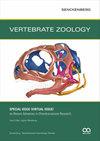白毛菊和白毛菊的杂交带:来自自然学家和遗传学的表型数据显示了一致的曲线和种诊断形态学特征的价值
IF 2.3
2区 生物学
Q1 ZOOLOGY
引用次数: 3
摘要
利用来自德国、奥地利和意大利北部的2944条草蛇的地理参考照片记录,以及来自同一地区的草蛇的先前发表的mtDNA序列(n = 1062)和微卫星数据(n = 952),我们检验了颜色和图案是否可靠地允许区分Natrix Natrix和n . helvetica,如果是的话,表型和遗传学显示的分布模式是否一致。此外,我们使用跨杂交区域的梯度分析来测试从一个物种到另一个物种的表型转变是否与遗传学揭示的陡峭梯度相似。我们的研究结果表明,这两个物种可以通过颜色和图案可靠地区分。最有力的诊断特征是身体两侧有无侧杠,枕斑的数量和后深色枕斑的形状。形态学鉴定的北毛茛和helvetica的分布与其遗传鉴定的范围相吻合。在分布范围内,单个相互冲突的个体在形态上被鉴定为nn . natrix或杂种,可能是误认或易位的蛇。对于遗传标记和表型,我们的渐变分析显示在杂交区有一致的陡峭曲线。然而,由于没有足够的遗传数据,应该对意大利杂交带的南部进行更详细的研究,因为表型数据表明该地区有一个平滑的渐变。这一地区具有背条纹的杂种所占比例之高令人意外,这也需要进一步的研究。对于德国西北部,另一个没有基因验证记录的地区,iNaturalist的数据表明,N. natrix和N. helvetica的接触区在埃姆斯河附近,并从那里向东南延伸到北莱茵-威斯特伐利亚的Höxter地区。本文章由计算机程序翻译,如有差异,请以英文原文为准。
Hybrid zones of Natrix helvetica and N. natrix: Phenotype data from iNaturalist and genetics reveal concordant clines and the value of species-diagnostic morphological traits
Using georeferenced photographic records of 2944 grass snakes from Germany, Austria, and northern Italy as well as previously published mtDNA sequences (n = 1062) and microsatellite data (n = 952) for grass snakes from the same regions, we examined whether or not coloration and pattern reliably allow to differentiate between Natrix natrix and N. helvetica and if so, whether the distribution patterns revealed by phenotypes and genetics are congruent. Furthermore, we used cline analyses across hybrid zones to test whether the phenotypic transition from one species to the other parallels the steep clines unveiled by genetics. Our results suggest that the two species can be reliably differentiated using coloration and pattern. The most powerful diagnostic traits are the presence/absence of side bars on the body flanks, the number of occipital spots, and the shape of the posterior dark occipital spot. The distributions of morphologically identified N. natrix and N. helvetica match their genetically confirmed ranges. Single conflicting individuals morphologically identified as N. natrix or hybrids within the distribution range of N. helvetica either represent misidentifications or translocated snakes. For the genetic markers and phenotypes, our cline analyses revealed concordant steep clines across hybrid zones. However, the southern part of the hybrid zone in Italy, for which no sufficient genetic data are available, should be studied in more detail because the phenotypic data suggest a smooth cline in this region. The unexpected high percentage of putative hybrids with dorsal stripes in this region also calls for further research. For northwestern Germany, another region for which no genetically verified records are available, iNaturalist data suggest that the contact zone of N. natrix and N. helvetica is near the Ems River and extends from there southeastwards to the region of Höxter, North Rhine-Westphalia.
求助全文
通过发布文献求助,成功后即可免费获取论文全文。
去求助
来源期刊

Vertebrate Zoology
ZOOLOGY-
CiteScore
4.00
自引率
19.00%
发文量
42
审稿时长
>12 weeks
期刊介绍:
Research fields covered by VERTEBRATE ZOOLOGY are taxonomy, morphology, anatomy, phylogeny (molecular and morphology-based), historical biogeography, and palaeontology of vertebrates.
 求助内容:
求助内容: 应助结果提醒方式:
应助结果提醒方式:


